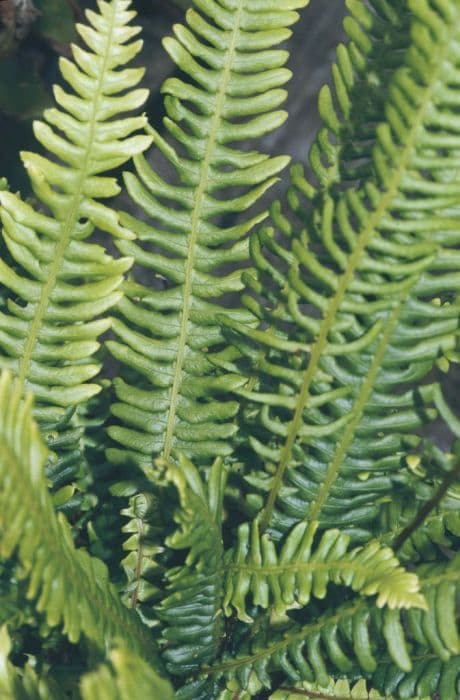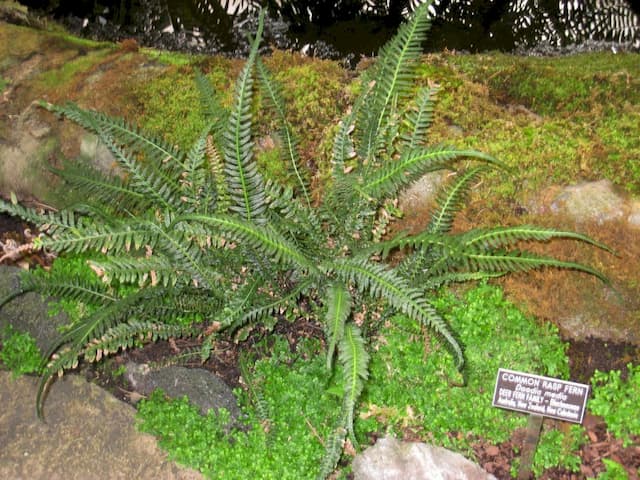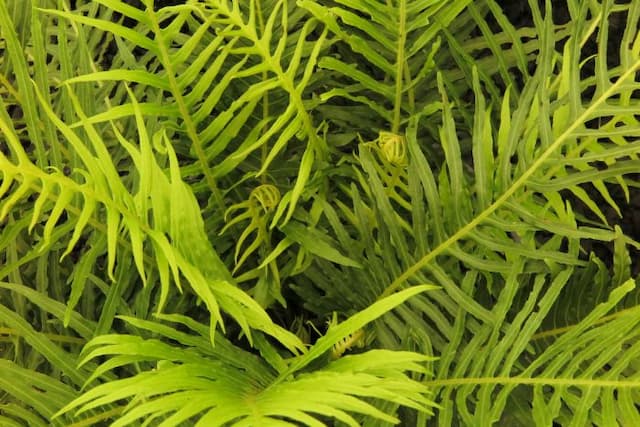Alpine water fern Blechnum penna-marina

ABOUT
Blechnum penna-marina, commonly known as alpine water fern, is a perennial fern characterized by its glossy, dark green fronds that form a low, dense mat. The fronds are divided into numerous small, rounded or oblong leaflets that are arranged in an alternating pattern along a central stem, giving them a feathery appearance. The leaflets can vary in shape, but they are typically elongated with smooth edges, and they may sometimes have a slightly serrated margin. The alpine water fern's fronds emerge upright and then arch gracefully outward, creating a textured and layered look. During different seasons, the color of the fronds can range from deep green to a reddish-bronze, adding to the visual interest of the plant. On the underside of the fronds, one can usually find reproductive structures known as spores, which are often covered by a protective tissue. These spores are essential for the plant's reproduction and are a characteristic feature of ferns in general. The overall appearance of alpine water fern is lush and vibrant, often providing a contrast to surrounding rocks, gravel, or other plants in its native habitat. Its ability to form dense clusters makes it an attractive ground cover and a popular choice for gardens that aim to create a natural or woodland aesthetic.
About this plant
 Names
NamesFamily
Blechnaceae
Synonyms
Alpine Water Fern, Pinque, Little Hard Fern
Common names
Lomaria alpina, Lomaria penna-marina, Lomaria boryana, Blechnum alpinum, Struthiopteris penna-marina.
 Toxicity
ToxicityTo humans
Alpine water fern (Blechnum penna-marina) is not commonly known to be toxic to humans. There is limited information on the toxicity of this specific fern species. As with many plants, it is generally advisable not to ingest plant material that is not known to be safe or edible. If a person does ingest Alpine water fern and experiences symptoms, it would be prudent to seek medical advice.
To pets
Alpine water fern (Blechnum penna-marina) is not widely reported to be toxic to pets. However, as with any non-food plant, it is possible that some pets may have a sensitivity or allergic reaction to the plant if ingested. Symptoms could include vomiting, diarrhea, or an upset stomach. If a pet does ingest Alpine water fern and shows adverse symptoms, it is recommended to consult a veterinarian.
 Characteristics
CharacteristicsLife cycle
Perennials
Foliage type
Evergreen
Color of leaves
Green
Height
1 foot (30 cm)
Spread
1 foot (30 cm)
Plant type
Fern
Hardiness zones
7
Native area
South America
Benefits
 General Benefits
General Benefits- Erosion Control: Alpine water fern's root system stabilizes soil, reducing erosion in sloped gardens and landscapes.
- Ground Cover: Its dense growth habit provides an effective ground cover, suppressing weed growth and maintaining soil moisture.
- Aesthetic Appeal: With its attractive evergreen leaves, alpine water fern adds visual interest to gardens, particularly in rockeries and shady spots.
- Low Maintenance: Alpine water fern requires minimal care once established, making it a convenient choice for busy gardeners.
- Wildlife Habitat: The plant can provide shelter and habitat for small insects and other fauna, enhancing biodiversity.
- Cold Tolerant: It is well-suited to cooler climates, allowing gardeners in such regions to cultivate an evergreen species throughout the year.
 Medical Properties
Medical PropertiesThis plant is not used for medical purposes.
 Air-purifying Qualities
Air-purifying QualitiesThis plant is not specifically known for air purifying qualities.
 Other Uses
Other Uses- Alpine Water Fern (Blechnum penna-marina) can be used in rock gardens for ground cover due to its compact and spreading habit, providing an evergreen carpet amongst stones and boulders.
- The plant serves as a moderate feed for certain types of livestock such as sheep when other forage is not available, although it should be used sparingly due to its potential bitterness and low nutritional content.
- In landscaping, Alpine Water Fern is utilized for erosion control on slopes thanks to its ability to form dense mats that hold the soil in place.
- Some gardeners use the fern to create a "fernery" or a shaded fern garden, taking advantage of its tolerance for cool, shady conditions.
- Due to its attractive foliage, Alpine Water Fern is employed in floral arrangements, especially in creating naturalistic and woodland-inspired designs.
- The fern can be grown in containers and terrariums for indoor decoration, providing a touch of greenery in a controlled environment.
- It can serve as a living mulch in the garden, suppressing weeds and maintaining soil moisture with its spreading fronds.
- Alpine Water Fern is sometimes used to complement water features or ponds as its name suggests a natural affinity to water, enhancing the aesthetic of aquatic landscapes.
- The plant can be a subject for botanical illustration and study because of its distinctive foliage and growth habit which are of interest to botanists and artists alike.
- In colder regions, Alpine Water Fern may be used in winter gardens, as some varieties are frost-resistant and can provide green color throughout the year.
Interesting Facts
 Feng Shui
Feng ShuiThe Alpine Water Fern is not used in Feng Shui practice.
 Zodiac Sign Compitability
Zodiac Sign CompitabilityThe Alpine Water Fern is not used in astrology practice.
 Plant Symbolism
Plant Symbolism- Resilience: Blechnum penna-marina, commonly known as Alpine Water Fern, often grows in challenging conditions, such as alpine and subantarctic climates, symbolizing the ability to thrive in tough environments.
- Protection: As a fern, the Alpine Water Fern is associated with protection, due to the way fern leaves create a canopy in the wild, providing shelter to smaller plants and creatures.
- Eternal Youth: Ferns, in general, are considered symbols of youth and new beginnings as they are ancient plants that continue to thrive, and the Alpine Water Fern shares this symbolic meaning.
- Secret Bond: Throughout history, ferns have symbolized secret love and bonds, as their quiet and unassuming presence often goes unnoticed, mirroring the subtleties of a secret relationship.
 Water
WaterFor the Alpine Water Fern, ensure consistent moisture by watering it lightly but frequently. The goal is to mimic the plant's natural damp environment without saturating the soil, which could lead to root rot. Watering with approximately half a gallon every week should suffice, but adjust based on the humidity and temperature of your environment, ensuring the top inch of soil remains somewhat moist between watering sessions.
 Light
LightThe Alpine Water Fern thrives best in partial shade to full shade conditions, avoiding direct sunlight which can scorch its delicate fronds. It is ideal to place the plant in a north-facing or east-facing spot where it can benefit from the soft, filtered light. Ensure it receives consistent but gentle lighting throughout the day to maintain its vibrant foliage.
 Temperature
TemperatureThe Alpine Water Fern prefers cooler climates within the range of 60 to 75 degrees Fahrenheit and can survive short periods down to about 50 degrees Fahrenheit. It is not tolerant of high heat, and temperatures consistently above 80 degrees Fahrenheit can stress the plant. Ensure a stable environment away from draughts and sudden temperature swings to keep your fern healthy.
 Pruning
PruningPrune the Alpine Water Fern sparingly to remove damaged or dead fronds, which helps maintain the plant's health and appearance. This light pruning can be done at any time of the year as needed. It is not necessary to prune for shaping or size control, as the fern naturally maintains a compact form.
 Cleaning
CleaningAs needed
 Soil
SoilAlpine Water Fern thrives in well-draining soil with high organic matter. A mix of peat, loam, and sand, in equal parts, is suitable. Aim for a slightly acidic soil pH of 5.5 to 6.5 for optimal growth.
 Repotting
RepottingThe Alpine Water Fern should be repotted every 2-3 years, or when it outgrows its current container, to ensure continued growth and health.
 Humidity & Misting
Humidity & MistingAlpine Water Fern prefers high humidity levels, ideally between 60-80% for optimal growth.
 Suitable locations
Suitable locationsIndoor
Place Alpine Water Fern in bright, indirect light and maintain high humidity.
Outdoor
Grow Alpine Water Fern in dappled shade; shield from harsh sun.
Hardiness zone
7-9 USDA
 Life cycle
Life cycleAlpine water fern (Blechnum penna-marina) starts its life as a spore released from the mature fern's sporangia typically found underneath its leaves. These spores germinate to produce a small, heart-shaped gametophyte, which is the sexual phase of the plant. The gametophyte houses both male and female reproductive organs, and when conditions are favorable, fertilization occurs, leading to the growth of a new sporophyte. This sporophyte emerges as a tiny fern that will grow and mature, developing a rhizome and fronds. As the alpine water fern matures, it develops sori on the underside of its fronds where new spores are produced, completing the life cycle. This fern prefers damp, shady conditions and can spread both by spores and vegetatively through its creeping rhizomes, allowing for both sexual and asexual reproduction.
 Propogation
PropogationPropogation time
Spring to Summer
The Blechnum penna-marina, commonly known as alpine water fern, is most effectively propagated through spore collection and sowing. Spores are tiny, dust-like particles found on the underside of the fern's fronds, typically maturing during summer. To propagate, collect ripe spores from a healthy plant and sow them on the surface of a fine, sterile potting mix, ensuring high humidity and warm temperatures around 68°F (20°C). It is crucial to avoid direct sunlight, as it can hinder germination. The spores need consistent moisture to germinate, which may take several weeks to months. Once the spores have developed into prothalli, the gametophyte stage, fertilization occurs in the moist environment, eventually leading to the growth of new fern plants. This method of propagation requires patience and attention to the delicate nature of spores and young ferns.




